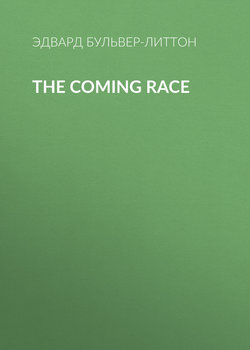The Coming Race

Реклама. ООО «ЛитРес», ИНН: 7719571260.
Оглавление
Эдвард Бульвер-Литтон. The Coming Race
Chapter I
Chapter II
Chapter III
Chapter IV
Chapter V
Chapter VI
Chapter VII
Chapter VIII
Chapter IX
Chapter X
Chapter XI
Chapter XII
Chapter XIII
Chapter XIV
Chapter XV
Chapter XVI
Chapter XVII
Chapter XVIII
Chapter XIX
Chapter XX
Chapter XXI
Chapter XXII
Chapter XXIII
Chapter XXIV
Chapter XXV
Chapter XXVI
Chapter XXVII
Chapter XXVIII
Chapter XXIX
Отрывок из книги
With the morning my friend’s nerves were rebraced, and he was not less excited by curiosity than myself. Perhaps more; for he evidently believed in his own story, and I felt considerable doubt of it; not that he would have wilfully told an untruth, but that I thought he must have been under one of those hallucinations which seize on our fancy or our nerves in solitary, unaccustomed places, and in which we give shape to the formless and sound to the dumb.
We selected six veteran miners to watch our descent; and as the cage held only one at a time, the engineer descended first; and when he had gained the ledge at which he had before halted, the cage rearose for me. I soon gained his side. We had provided ourselves with a strong coil of rope.
.....
Quitting this hall, my guide led me through a gallery richly painted in compartments, with a barbaric mixture of gold in the colours, like pictures by Louis Cranach. The subjects described on these walls appeared to my glance as intended to illustrate events in the history of the race amidst which I was admitted. In all there were figures, most of them like the manlike creatures I had seen, but not all in the same fashion of garb, nor all with wings. There were also the effigies of various animals and birds, wholly strange to me, with backgrounds depicting landscapes or buildings. So far as my imperfect knowledge of the pictorial art would allow me to form an opinion, these paintings seemed very accurate in design and very rich in colouring, showing a perfect knowledge of perspective, but their details not arranged according to the rules of composition acknowledged by our artists—wanting, as it were, a centre; so that the effect was vague, scattered, confused, bewildering—they were like heterogeneous fragments of a dream of art.
We now came into a room of moderate size, in which was assembled what I afterwards knew to be the family of my guide, seated at a table spread as for repast. The forms thus grouped were those of my guide’s wife, his daughter, and two sons. I recognised at once the difference between the two sexes, though the two females were of taller stature and ampler proportions than the males; and their countenances, if still more symmetrical in outline and contour, were devoid of the softness and timidity of expression which give charm to the face of woman as seen on the earth above. The wife wore no wings, the daughter wore wings longer than those of the males.
.....